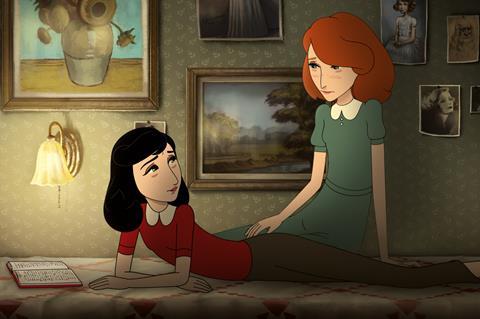Ari Folman sets his animation a year in the future in this ‘bold attempt to combine family entertainment and politics’

Dir/scr: Ari Folman. Belgium. 2021. 99 mins
An inventive riffing animation which takes ’The Diary Of Anne Frank’ as a jumping-off point to explore contemporary thematic parallels, Ari Folman’s latest is a bold attempt to combine family entertainment and politics. The setting is one year from now: a violent storm lashes the streets of Amsterdam, buffeting the queues of visitors shuffling outside the Anne Frank museum. Inside the building, a young girl with flaming red hair materialises. She is Kitty – the imaginary friend to whom Anne Frank addressed her diary. The film weaves together her quest to find Anne in modern day Amsterdam with dramatised excerpts from Anne’s journal.
The book is a portal which links the near future with the distant past
The profile of the widely beloved book is likely to be both an asset and an impediment for the film. Purists might chafe at everything from the looping liberties that Folman takes with the text to the stylised representation of Anne herself; other fans might appreciate the film’s attempts to channel Anne’s vivid and playful imagination. The picture, while bracingly unconventional in its storytelling, is pitched at younger audiences when it comes to its blunt political message, a fact which might create something of a dissonance. After all, children can be rather dogmatic about the correct way for their favourite stories to be told. Still, there’s much to admire here, particularly in Karen O’s electronic score and a striking visual approach which features something of the trademark trippiness that characterised Folman’s earlier animation, Waltz With Bashir. It’s worth noting that in 2017, Folman and illustrator David Polonsky published Anne Frank’s diary as a graphic novel, and that Where Is Anne Frank is the first film to be supported by The Anne Frank Fonds Basel.
When Kitty first appears in the hallowed rooms of the museum, she’s a timid wraith, invisible to the plodding tourists gazing sightlessly at the Frank family artefacts. It’s not until she plucks up the courage to leave the building, clutching Anne’s diary like a talisman, that she gains a physical form and the ability to interact with the people around her. Her quest – to find Anne – takes her from the police station to a theatre to a school library. But she gains the most insight from Peter, a pickpocket, who lifts the fat wallets of the lumbering tourists in the museum. Through him she learns about the plight of the modern day refugees who have taken shelter in a squatted warehouse.
The book is more than a plaid-covered journal, it’s a kind of portal which links the near future with the distant past. The words swirl from the pages and take the form of memories and confidences that Anne shared with Kitty. But these memories are fluid and given to embellishments – Anne’s marching band of suitors from the time before the children started to be sent away; a particularly lovely sequence in which Anne and Peter escape into the inside of a radio, a hidden wonderland of luminous valves and humming fragments of voices caught in the airwaves. Moments like this imbue the film with a beguiling magic, a lightness which goes some way to disarming the slightly heavy-handed approach to the film’s political message.
Production companies: Purple Whale Films, Walking The Dog, Samsa Film, Brigit Folman Gang, Submarine Film, Le Pacte
International sales: Wild Bunch International
Producers: Jani Thiltges, Ari Folman
Animation: Yoni Goodman
Cinematography: Tristan Oliver
Editor: Nili Feller
Music: Karen O, Ben Goldwasser
Main cast: Emily Carey, Ruby Stokes, Tracy Ann Oberman, Sebastian Croft, Ralph Prosser, Michaël Maloney
























No comments yet